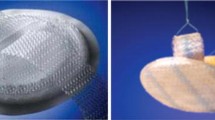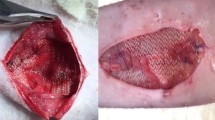Abstract
Background
The ideal mesh for laparoscopic ventral hernia repair is not yet identified.
Methods
We laparoscopically placed polypropylene (PPM), expanded polytetrafluoroethylene (ePTFE), and polyester with antiadhesive collagen layer (PCO) in eight pigs using sutures and tacks for fixation. After 28-day survival, we compared adhesion formation, fibrous ingrowth, and shrinkage among the types of mesh.
Results
Mean area of adhesions to PCO (8.25%) was less than that to ePTFE (57.14%, p < 0.001) or PPM (79.38%, p < 0.001). Adhesions peel strength was less for PCO (2.3 N) than for PPM (16.1 N, p < 0.001) or ePTFE (8.8 N, p = 0.02). Peel strength of mesh from the abdominal wall was less for ePTFE (1.3 N/cm of mesh width) than for PCO (2.8 N/cm, p = 0.001) or PPM (2.1 N/cm, p = 0.05). ePTFE area (94.4 cm2) was less than that for PCO (118.6 cm2, p < 0.001) or PPM (140.7 cm2, p < 0.02).
Conclusion
PCO had fewer and less severe adhesions than ePTFE or PPM while facilitating excellent ingrowth of the adjacent parietal tissue.








Similar content being viewed by others
References
PK Amid AG Shulman IL Lichtenstein et al. (1994) ArticleTitleExperimental evaluation of a new composite mesh with the selective property of incorporation to the abdominal wall without adhering to the intestines J Biomed Mater Res 28 373–375 Occurrence Handle10.1002/jbm.820280312 Occurrence Handle8077252
JM Bellon LA Contreras J Bujan et al. (1999) ArticleTitleEffects of relaparotomy through previously integrated polypropylene and polytetrafluoroethylene experimental implants in the abdominal wall J Am Coll Surg 188 466–472 Occurrence Handle10.1016/S1072-7515(99)00029-0 Occurrence Handle10235573
Borrazzo EC, Belmont MF, Doffa D, Fowler DF (2004) Effect of prosthetic material on adhesion formation after laparoscopic ventral hernia repair in a porcine model. Surg Endosc 18: 108–112
H Ellis BJ Moran JN Thompson et al. (1999) ArticleTitleAdhesion related hospital readmissions after abdominal and pelvic surgery: a retrospective cohort study Lancet 353 1476–1480 Occurrence Handle10.1016/S0140-6736(98)09337-4 Occurrence Handle10232313
BT Heniford A Park BJ Ramshaw G Voeller (2003) ArticleTitleLaparoscopic repair of ventral hernias: nine years’ experience with 850 consecutive hernias Ann Surg 238 391–400 Occurrence Handle14501505
Z Kaufman M Engelberg M Zager (1981) ArticleTitleFecal fistula: a late complication of Marlex mesh repair Dis Col Rectum 24 53–54
GE Leber JL Garb AL Alexander et al. (1998) ArticleTitleLong term complications associated with prosthetic repair of incisional hernias Arch Surg 133 378–382 Occurrence Handle10.1001/archsurg.133.4.378 Occurrence Handle9565117
RW Luijendijk DC Lange Particlede CC Wauters et al. (1996) ArticleTitleForeign material in postoperative adhesions Ann Surg 223 242–248 Occurrence Handle10.1097/00000658-199603000-00003 Occurrence Handle8604903
Luijendijk RW, Hop WC, vand den Tol MP, et al (2000) A comparison of suture repair with mesh repair for incisional hernia. N Engl J Med 343: 392–398
F Marchal L Brunaud H Sebbag et al. (1999) ArticleTitleTreatment of incisional hernias by placement of an intraperitoneal prosthesis: a series of 128 patients Hernia 3 141–147 Occurrence Handle10.1007/BF01195314
BD Matthews BL Pratt HS Pollnger et al. (2003) ArticleTitleAssessment of adhesion formation to intra-abdominal polypropylene mesh and polytetrafluoroethylene mesh J Surg Res 114 126–132 Occurrence Handle10.1016/S0022-4804(03)00158-6 Occurrence Handle14559437
D Mutter FR Jamali GT Moody et al. (2000) ArticleTitleThe concept of protected mesh to minimize adhesion foraiation in inteaperitoneal abdominal wall reinforcement. Preclinical evaluation of a new composite mesh Hernia 4 S3–S9 Occurrence Handle10.1007/BF01387175
AE Park DW Birch P Lorics (1998) ArticleTitleLaparoscopic and open incisional hernia repair: a comparison study Surgery 124 816–822 Occurrence Handle10.1067/msy.1998.92102 Occurrence Handle9781006
J Rives JC Pire JB Flament et al. (1985) ArticleTitleTreatment of large eventrations. New therapeutic indications apropos of 322 cases Chirurgie 111 215–225 Occurrence Handle2934236
RE Stoppa (1989) ArticleTitleThe treatment of complicated groin and incisional hernias World J Surg 13 545–554 Occurrence Handle10.1007/BF01658869 Occurrence Handle2683400
M Therin D Mutter P Diemunsch GT Rodeheaver (1998) ArticleTitlePreclinical evaluation of a new composite mesh (collagen-polyester) for intraperitoneal hernia repair with the selective property of tissue incorporation on one side without adhesion formation on the opposite side Hernia 2 S27
GR Voeller B Ramshaw AE Park BT Heniford (1999) ArticleTitleIncisional hemia J Am Coll Surg 189 635–637 Occurrence Handle10.1016/S1072-7515(99)00224-0 Occurrence Handle10589602
GE Wantz (1991) ArticleTitleIncisional hernioplasty with Mersilene Surg Gynecol Obrstet 172 129–137
Acknowledgment
This research was funded by a grant from Sofradim Corporation, Trévoux, France.
Author information
Authors and Affiliations
Corresponding author
Rights and permissions
About this article
Cite this article
McGinty, J.J., Hogle, N.J., McCarthy, H. et al. A comparative study of adhesion formation and abdominal wall ingrowth after laparoscopic ventral hernia repair in a porcine model using multiple types of mesh. Surg Endosc 19, 786–790 (2005). https://doi.org/10.1007/s00464-004-8174-9
Received:
Accepted:
Published:
Issue Date:
DOI: https://doi.org/10.1007/s00464-004-8174-9




